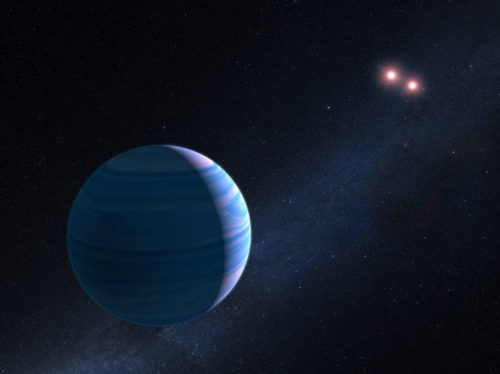- “This artist’s illustration shows a gas giant planet circling a pair of red dwarf stars in the system OGLE-2007-BLG-349, located 8,000 light-years away,” reports Nasa.gov. ” ” The two red dwarf stars are 7 million miles apart.” source: nasa.gov
By: Ethan Lichtenberg
The Sun is known as the life line for humanity for it keeps humans alive. The Sun is a little over 90 million miles away from the Earth, which is a suitable distance allowing for Earth to be inhabitable.
NASA reports that on Sept. 22 the Hubble Telescope discovered a planet that orbits, not one sun, but two suns. This is a huge discovery in the astronomy world because, while there are other small planets that orbit more than one red dwarf star, this is the largest. One goal of most astronomers in this day and age is to question whether or not life can survive on other planets. The planet they discovered is called OGLE-2007-BLG-349.
This alien planet is “located 8,000 light-years from Earth toward the very center of the Milky Way,” according to NASA, and it is near the constellation Sagittarius. It was first spotted in 2007 by telescopes based on the ground all around the world, reported CBS News. Initially, astronomers identified the system as a planet orbiting only one star. However, their data did suggest that there was a third object, but the researchers weren’t able to identify it at the time. Not until September were the Astronomers able to claim that this planet had two suns, instead of one.
This is not the first time they have seen something like this; however, space.com claims there have been many planets that orbit bigger, surrounding red dwarf stars like this, but this is the first one with a circumbinary system. In these “circumbinary systems,” two stars orbit one common center of mass. From our place on Earth, gravity from the closer star, or sun, “bends and magnifies the light coming from the star in the background,” said NASA, and one after the other it continues to orbit.
This kind of technique is called “gravitational microlensing,” according to astro.cornell.edu. In fact, astro.cornell.edu reports that when a nearby, small star “passes directly between the Earth and a more distant star, the smaller object’s gravitational field acts as a lens to bend and focus the light. If the smaller objects path takes it precisely in front of the other one, the image formed by the ‘gravitational lens’ is a circular ring, referred to as an ‘Einstein Ring.’”
According to NASA, an “Einstein Ring” in Astronomy, is the deformation of the light from a source, such as a galaxy or a star into a ring through gravitational lensing of the source’s light by an object with an extremely large mass like another galaxy or a black hole. This is especially intriguing for astronomers who can use this bent light to study the surrounding area. They can see if there are any other stars in the system, and see any clues as to the environment of this planet, according to space.com. “The focusing of the light passing around the edges of the object towards the Earth causes a sudden and temporary increase in the brightness of the distant star”, said astro.cornell.edu.
Once they began receiving information from the Hubble Telescope and “gravitational microlensing,” “the ground-based observations suggested two possible scenarios for the three-body system: a Saturn-mass planet orbiting a close binary star pair or a Saturn-mass and an Earth-mass planet orbiting a single star,” said David Bennett, a researcher at NASA’s Goddard Space Flight Center in Greenbelt, Maryland.
According to space.com, while “gravitational microlensing” is a great tool in finding if there are stars surrounding the planet, the best tool astronomers have today is the Hubble Telescope. Space telescopes take much more detailed photos of deep space than those telescopes that are land-based.
Hubble’s high-resolution images revealed that the system has the brightness expected of two closely orbiting red dwarf stars. This information then led them to the conclusion that there was one Saturn-mass planet orbiting a close binary star pair. In simple terms, this information gave them the ability to say that OGLE-2007-BLG-349 is a planet near the size of Saturn, and has two suns.
This claim that NASA made in the Astronomical Journal was so ground breaking because it was the first time that “gravitational microlensing” was used to discover a circumbinary planet. NASA and the astronomy community took a huge step in this discovery. A discovery that has and will continue to get much attention. This is not the first and certainly not the last planet they will discover.






